Jobs in Australia for Filipino 2025
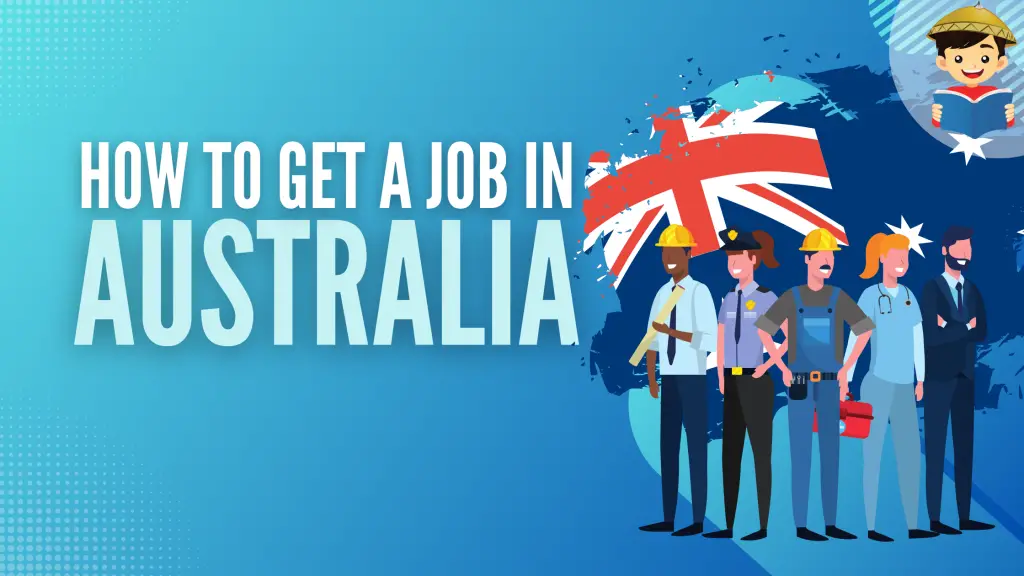
Thinking of finding a job in Australia? Well, you can learn from the others that came before you.
Many Filipinos now call Australia their home. They are the fifth largest migrant community group7 in Australia according to the Australian Bureau of Statistics. There were about 310,000 Filipinos in Australia in 2020, growing by 28.5% from 2015.
According to 2016-2020 data from the Australian Department of Home Affairs8, many Filipinos had found jobs there as registered nurses, motor mechanics, welders, and cooks. But when COVID-19 hit, Australia closed its borders.
Now that Australia’s borders have been reopened9, migrant workers are also expected to grow in number to help address labor shortages in the country.
If you are looking for an opportunity to find work in Australia, now would be a good time to start your preparations with the help of this guide.
Table of Contents
Top 10 Most In-Demand Jobs in Australia for Filipinos
The Philippine Overseas Employment Administration, or POEA (now the Department of Migrant Workers or DMW), validates job orders from Australia and other countries to ensure that the rights of OFWs are protected. They maintain a database of these validated jobs and update the list regularly.
The list below shows the top 10 most in-demand jobs in Australia for Filipinos based on the POEA database 2021-2022.
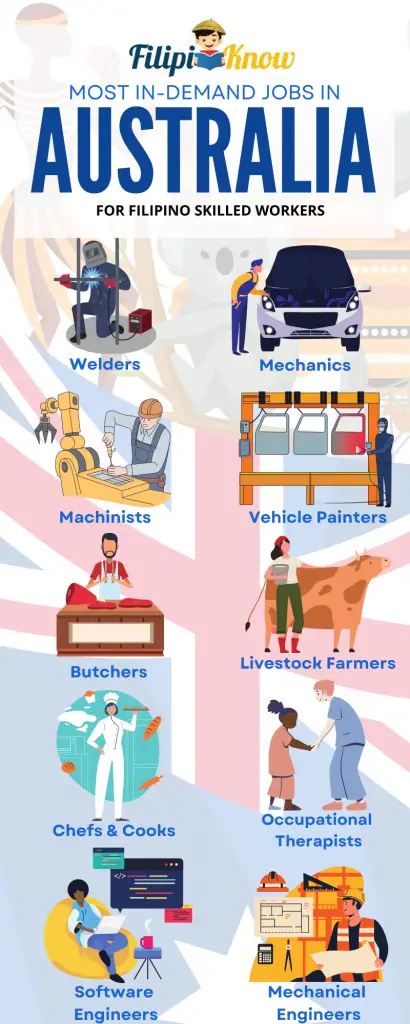
1. Welders, Fabricators & Other Metal Workers
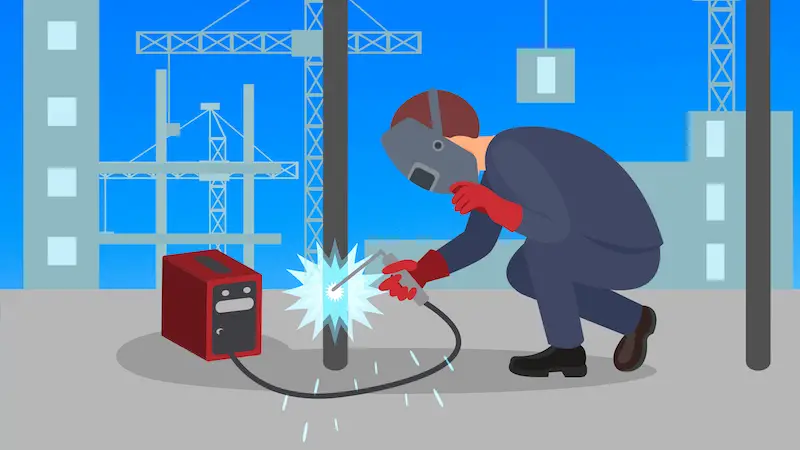
Job Overview: Structural steel and welding trades workers10 are adept in repairing, cutting, and joining metal for boilers, pipes, ships, and other structures. Their tasks include studying blueprints, cutting metal, aligning parts, and finishing iron and steel products.
Average Salary:
- Welders – $35.73/hr (in AUD, based on data from SalaryExpert)
Requirements:
- The equivalent of AQF Certificate III, including at least two years of on-the-job training, or AQF Certificate IV; or at least three years of equivalent experience in the same field
- Some employers may require relevant experience or on-the-job training in addition to the formal qualification
Job Variations: Fabricator General, Fabricator Metal, Fabricator Welding, Boilermaker, Welder Coded, Welder Fitter, Welder Pressure, Welder First Class, Welder Special Class
2. Automotive Mechanics & Electricians
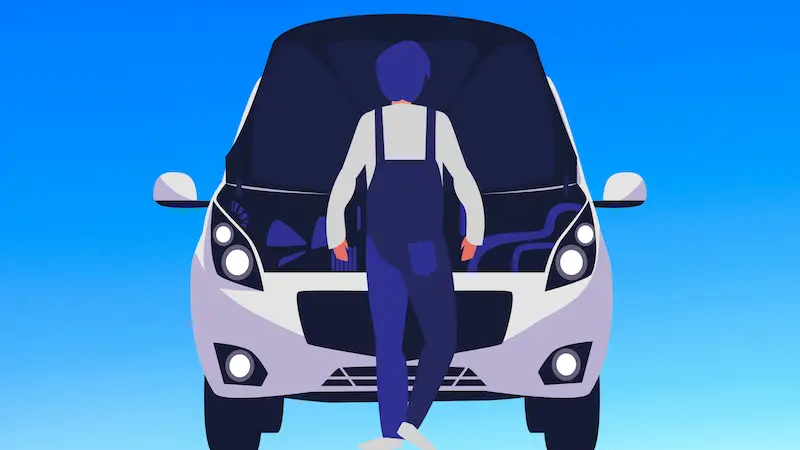
Job Overview: Automotive mechanics and electricians11 are skilled workers who repair and maintain large and small vehicles such as cars, trucks, and motorcycles. Automotive mechanics mainly handle mechanical systems such as engines and tires, while automotive electricians diagnose and repair the various electrical systems in vehicles.
Average Salary:
- Automotive Mechanic & Electrician – $32.57/hr
Requirements:
- The equivalent of AQF Certificate III, including at least two years of on-the-job training, or AQF Certificate IV; or at least three years of equivalent experience in the same field
- Professional registration or licensing may be required
- Some employers may require relevant experience or on-the-job training in addition to the formal qualification
Job Variations: Mechanic Diesel Motor, Mechanic Heavy-Duty Vehicle, Mechanic Light Vehicle, Mechanic Motor General, Mechanic Motorcycle, Electrician Automotive
3. Metal Fitters & Machinists

Job Overview: Metal fitters and machinists12 are experts in fitting and assembling metal parts into various products. They also set up and operate machining tools such as those used in the metal, textile, electronics, and plastic industries.
Average Salary:
- Metal Fitter – $35.27/hr
- Machinist – $35.76/hr
Requirements:
- The equivalent of AQF Certificate III, including at least two years of on-the-job training, or AQF Certificate IV; or at least three years of equivalent experience in the same field
- Some employers may require relevant experience or on-the-job training in addition to the formal qualification
Job Variations: Technician Mechanical, Technician Plastic, Technician Electronic, Technician Maintenance, Fitter General, Fitter Machinist, Fitter Turner, Fitter Mechanical
4. Vehicle Painters & Panel Beaters
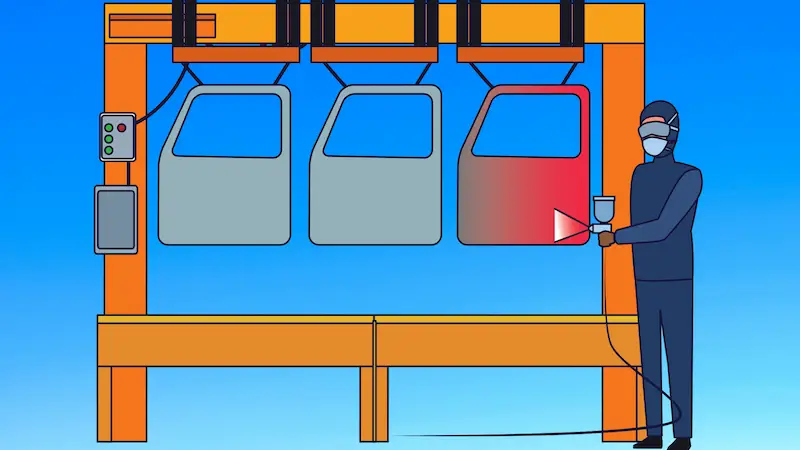
Job Overview: Unlike their mechanic counterparts, vehicle painters13 and panel beaters14 mainly work on the exterior bodies of large or small vehicles. Panel beaters repair the metal, fiberglass, and plastic bodies of vehicles. Meanwhile, vehicle painters would remove the rough spots and apply paint to make them look new.
Average Salary:
- Vehicle Painter – $37.45/hr
- Panel Beater – $30.01/hr
Requirements:
- The equivalent of AQF Certificate III, including at least two years of on-the-job training, or AQF Certificate IV; or at least three years of equivalent experience in the same field
- Professional registration or licensing may be required
- Some employers may require relevant experience or on-the-job training in addition to the formal qualification
Job Variations: Beater Panel, Body Builder Vehicle, Painter Automotive, Painter Auto Spray, Painter Spray Vehicle
5. Meat Boners, Slicers, and Slaughterers
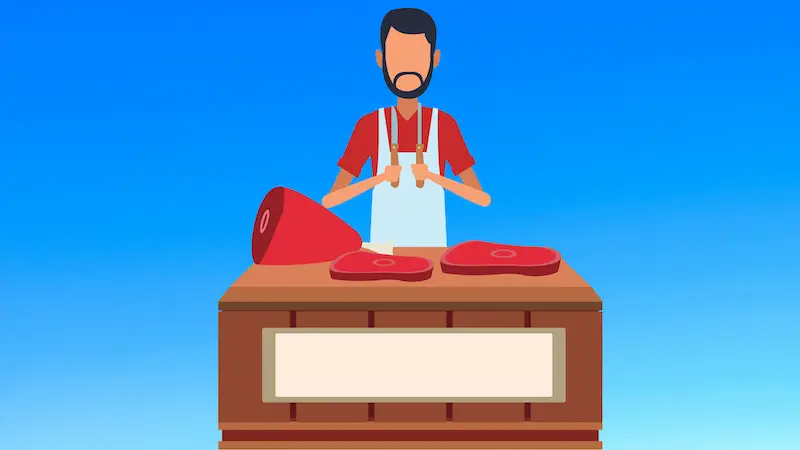
Job Overview: Working in slaughterhouses, meat workers15 like butchers are hired to turn livestock into raw meat products. Their tasks include operating machines to turn carcasses into meat cuts, separating fat and tissue around the bones, and scraping and washing the meat.
Average Salary:
- Meat Boner – $21.38/hr
- Meat Cutter – $22.79/hr
Requirements:
- The equivalent of AQF Certificate II or III (ANZSCO Skill Level 4); or at least one year of equivalent experience in the same field
- Some employers may require relevant experience or on-the-job training in addition to the formal qualification
Job Variations: Worker Abattoir, Worker Meat, Worker Meat/Butcher, Worker Skilled Meat
6. Livestock Farmers

Job Overview: Laborers who help operate livestock farms, such as sheep stations and piggeries, are also in demand in Australia. Livestock farmers16 help breed and raise livestock, maintain container fences, and organize transportation for livestock sales as part of their everyday activities.
Average Salary:
- Livestock farmers get around minimum wage ($20.33/hr)
Requirements:
- The equivalent skill of a bachelor’s degree or higher qualification in a related field; or at least five years of relevant experience in the same field
- Some employers may require relevant experience or on-the-job training in addition to the formal qualification (ANZSCO skill level 1)
Job Variations: Farmer Dairy Cattle, Farmer Pig, Stockperson, Stockperson Senior Piggery
7. Chefs & Cooks

Job Overview: Food trades workers, such as chefs17 and cooks18, are also in demand to help fill the gap in Australia’s food service establishments. Chefs plan and organize the menu and food preparation in these establishments. They also lead the cooks who help the chef prepare and cook various dishes.
Average Salary:
- Chefs – $27.87/hr
- Cooks – $21.62/hr
Requirements:
- For chefs: Equivalent of AQF Associate Degree, Advanced Diploma or Diploma (ANZSCO Skill Level 2); or at least three years of relevant experience in the same field
- For cooks: Equivalent of AQF Certificate III including at least two years of on-the-job training; or AQF Certificate IV; or at least three years of equivalent experience in the same field
Job Variations: Chef de Partie, Chef Sous
8. Occupational Therapists
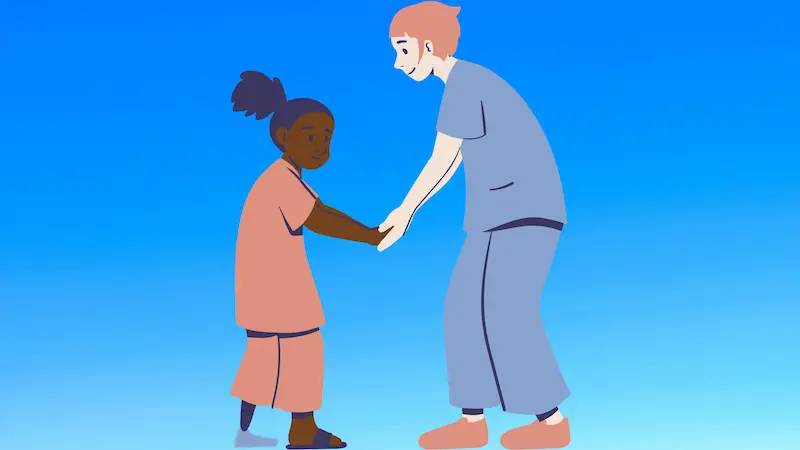
Job Overview: Occupational therapists19 provide therapy for people with illnesses or disabilities to help them perform their daily activities better. They assess their client’s whole capabilities, from physical to emotional, so that they can prescribe a therapy that meets their needs. They may be assigned to home, work, or school environments.
Average Salary:
- Occupational Therapist – $52.71/hr
Requirements:
- The equivalent skill of a bachelor’s degree or higher qualification in the occupational therapy field (ANZSCO Skill Level 1)
- Professional registration or licensing may be required
9. Software Engineers
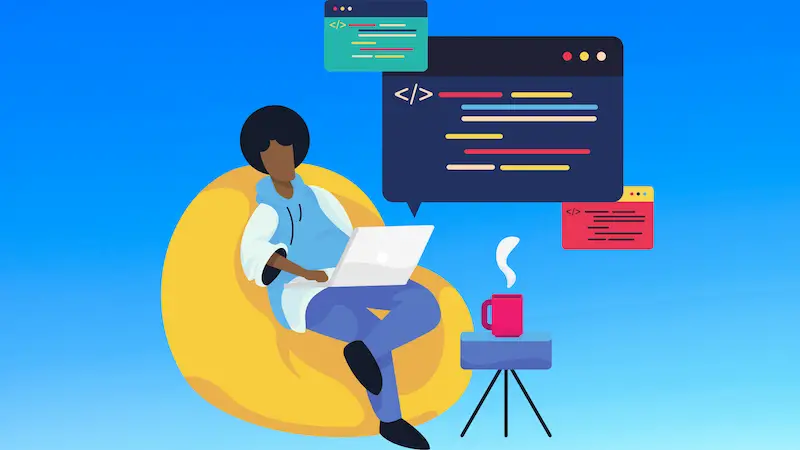
Job Overview: Software engineers or application programmers20 design and develop computer programs depending on the needs of their employers or clients. A software engineer would be adept at evaluating what a program needs, creating a roadmap to develop the said program, and doing the actual coding and debugging work.
Average Salary:
- Software Engineer – $70.76/hr
Requirements:
- The equivalent skill of a bachelor’s degree or higher qualification in the same field; or at least five years of relevant experience in the same field
- Some employers may require relevant experience or on-the-job training in addition to the formal qualification (ANZSCO skill level 1)
10. Mechanical Engineers
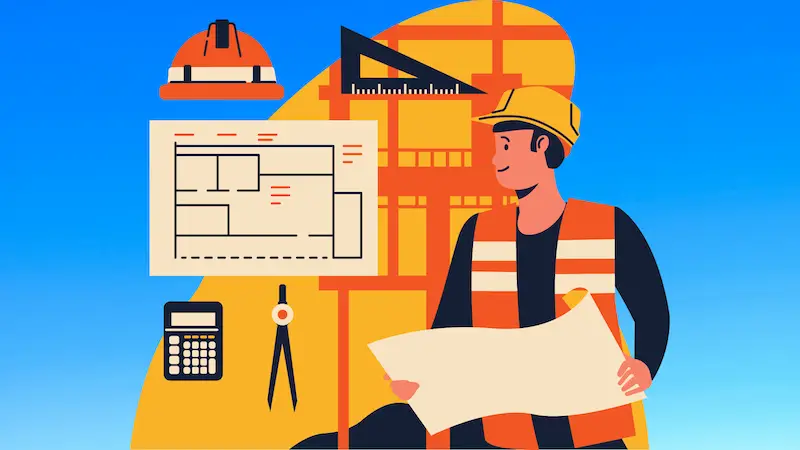
Job Overview: Mechanical engineers21 plan, design, and oversee the operation and maintenance of machinery and other kinds of mechanical installations. They must know how to design machines and components, establish manufacturing and installation standards, and supervise the maintenance of plant buildings and equipment.
Average Salary:
- Mechanical Engineer – $61.07/hr
Requirements:
- The equivalent skill of a bachelor’s degree or higher qualification in the field
- Some employers may require relevant experience or on-the-job training in addition to the formal qualification (ANZSCO skill level 1)
- Professional registration or licensing may be required
Job Variations: Engineer Mechanical Technician, Engineer Mechanical Draftsman, Engineering Technicians Mechanical, Engineer Mechanical/Aircraft Maintenance
Different Pathways To Get Work in Australia
There are a few different pathways to get work in Australia. Due to the limited slots and complicated processes, direct hire pathways are usually very competitive. Meanwhile, going through a POEA-accredited agency is much simpler, but you may not find the job you want there.
Here are the primary methods to find work in Australia:
1. SkillSelect
SkillSelect is an immigration program by the Australian Department of Home Affairs. It is considered a direct-hire method where you can send an expression of interest (EOI) to join the program through the department’s website22. They will then match you with an appropriate employer based on the employer’s needs.
To be eligible, your profession must be on the skilled occupation list23. There is a search bar at the bottom of that page that you can use to see if your profession is on the list.

Aside from the occupations, you can also see the corresponding ANZSCO code, visa, and assessment authority which differ for each profession. If you click on the ANZSCO code link, you will be taken to a page showing more job details.
When you send your EOI, you can select the visa you want to apply for. A points-based system will assess your skills, credentials, age, and other relevant factors. The higher your points, the higher the chance of you being invited.
The main drawback to this system is that it is very competitive, and you may not even be considered if you do not get enough points. Based on January 2022 data from the SkillSelect database, only 1% of applicants get invited.
Aside from that, since SkillSelect is a direct-hire pathway, it also means that when you get hired, you need to coordinate with Australian and Philippine government agencies to get your employment processed.
If you decide this is the path for you, manually compute your possible points. This way, you know what you can improve on before you pay an assessment authority to do it for you formally.
2. Online Job Boards
Online job boards such as Seek and CareerOne are also available as a direct-hire pathway. You can also find job postings on social media for professionals, such as LinkedIn.
However, please note that POEA currently imposes a direct-hire ban24 with very few exemptions. If you get hired directly by an employer, you still need to get your employer accredited by POEA. You would also need to coordinate with a POEA-accredited agency so that they can handle your recruitment. It takes a lot of time and work that may eventually put off your prospective employer.
3. POEA-Accredited Agencies
This is usually the simplest way to get work in other countries such as Australia, New Zealand, Japan, and Canada. These are not direct-hire jobs, so you don’t have to go through the complicated process of getting one approved.
Before these jobs are listed, POEA (now DMW) already validates them to ensure that OFWs are protected from scams, illegal recruitment, and other horrible labor practices. Agencies also undergo an accreditation process, and if they fail to comply with POEA’s standards, their licenses will be revoked.
How To Work in Australia: A Step-by-Step Guide
1. Apply for Work in Australia Through a POEA-Accredited Agency
Before you apply, you need to check if jobs are available for the professions you want. You can check the latest job orders from Australia through the DMW database.
If you want to check the database, select “Job Site” from the drop-down box (it’s chosen by default), then type the name of the country (in this case, “Australia”) in the search box provided.

Upon clicking the Search button, you’ll be taken to the database, where you can see the available jobs, the number of slots available, and the date the job was posted.
Once you find a job you want, check if it also appears in Australia’s skilled occupation list. Just type the name of the job in the search bar at the bottom of the page.
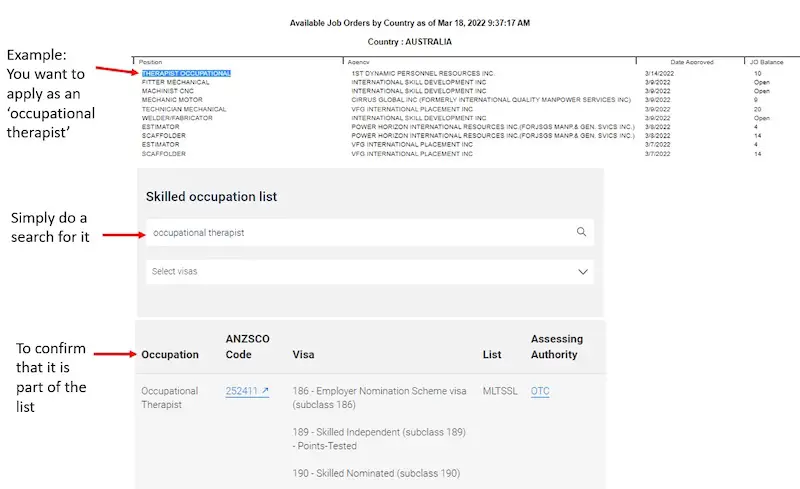
It’s essential to validate that the job you want is part of the list so that you don’t waste your time or money. You can also use the ANZSCO link next to the job name to learn more about the job.
After that, you must check if the agency offering your desired job has a valid license. You can do this easily by looking through DMW’s agency database. Type a part of the agency’s name in the search bar, and a result like the one below will appear.
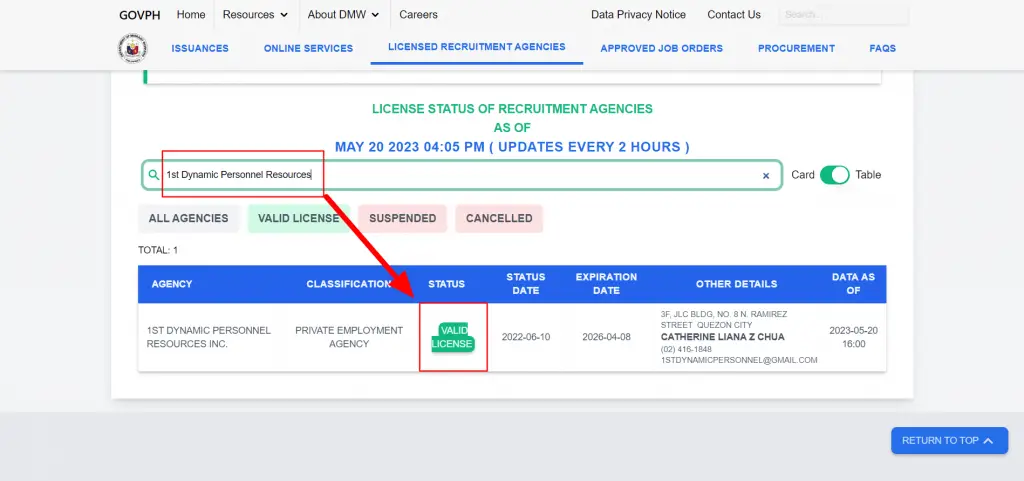
Before you contact the agency, make sure to update your resume and prepare for an interview. You want to put your best foot forward even if you only talk to the agency. After all, they will be the ones to recommend you to an employer.
Once you are done preparing, contact the agency and ask them about the requirements and next steps.
2. Get Your Australian Work Visa
After contacting your agency, it’s a good idea to research your visa options while waiting for progress in your application. Your visa options are dependent on the job you are applying for.
a. Check Your Visa Options
To check the available work visas, you must visit the skilled occupation list again. If you search for your job, you can see the visa/s you can apply for listed under the 3rd column.
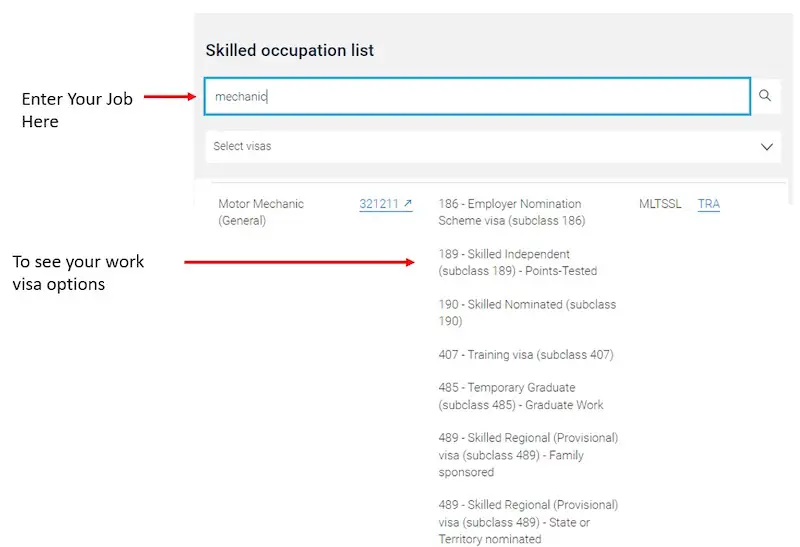
If you plan to become a permanent resident in Australia, then you should look for the following work visas:
| Permanent Work Visas | Details |
| 189 Skilled Independent (Points-Tested Stream)25 | You should be invited to apply for this permanent work visa and satisfy the points test. With this visa, you can work and study anywhere in Australia. It costs $4,115 and takes 53 days to 36 months to process. |
| 190 Skilled Nominated (Points-Tested Stream)26 | This visa is almost the same as 189, except an Australian state or territory must sponsor you. Meaning you may have some obligations to meet with regards to your sponsor, such as working in their state or territory. It also costs $4,115 but takes 4 to 22 months to process. |
| Temporary Work Visas (That Can Lead to Permanent Residence) | Details |
| 482 Temporary Skill Shortage (Medium Term Stream)27 | The medium-term stream version of the 482 work visa lets you stay for up to 4 years. The job you are applying for must be on the Medium and Long-term Strategic Skills List (MLTSSL) or the Regional Occupation List (ROL). You can check this on the skilled occupation list. It costs $2,690 and may take 33 days to 7 months to process. If you get this visa, you may choose from the next two options for a subsequent permanent visa. |
| 186 Employer Nomination Scheme (Temporary Residence Transition Stream)28 | This visa requires you to work with an Australian employer for at least three years. With this visa, you can live, work and study in Australia indefinitely and invite your family. It costs $4,115 and takes 4 to 20 months to process. |
| 187 Regional Sponsored Migration Scheme (Temporary Residence Transition Stream)29 | This visa is similar to 186, except it requires you to work and live in regional Australia. It also has a shorter processing time of 3 to 19 months. |
However, please do note that this is not a guaranteed way to get a permanent work visa. Both of the last two visas in the table above require a nomination from your employer, which will depend on your work performance and relationship with them.
| Provisional Work Visas | Details |
| 491 Skilled Work Regional (Provisional)30 | This visa is for skilled workers invited to apply by a state or territory, a government agency, or an eligible relative. You also have to satisfy the points requirement. With this visa, you can stay in Australia for 5 years and apply as a permanent resident after 3 years. It costs $4,115 and can take 78 days to 20 months to process. |
| 494 Employer-Sponsored Regional (Provisional) Employer-Sponsored Stream31 | With this visa, you can only work for your sponsor employer or associated entity. You can only live, study, and work in your designated regional area of Australia. It is valid for 5 years; you can apply as a permanent resident after 3 years. It costs $4,115 and can take 49 days to 8 months to process. |
Note that these work visas may not be your only option. The Department of Home Affairs adds or removes work visas depending on the needs of the country.
More than 40 work visas are listed on their website, and it can be overwhelming to sift through. Thankfully, you can always use the visa finder on their web page to help you navigate your options. You can also consult your recruitment agency regarding the best option.
b. Take a Language Test
Each visa has a different language test score requirement that you can check through their respective visa pages.
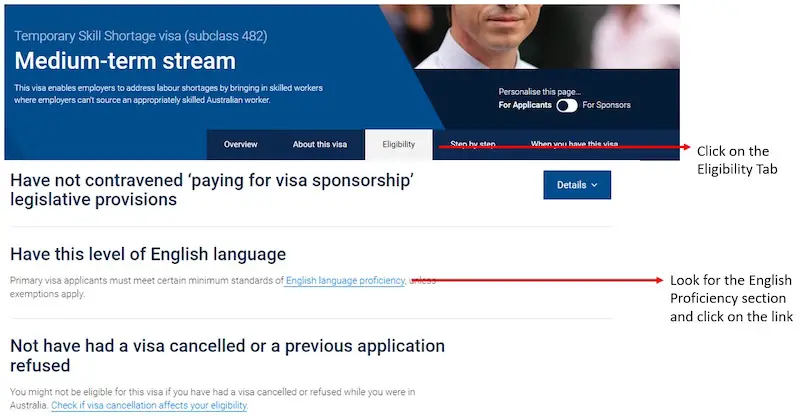
For example, the medium-term stream of 482 Temporary Skill Shortage visas requires an overall band score of 5 and no score lower than 5 in their IELTS results. Meanwhile, the employer-sponsored stream of 494 Employer-Sponsored Regional (Provisional) visas requires at least 6 on each of the 4 components of the IELTS.
c. Get Your Skills and Credentials Assessed
Each job has a different assessing authority assigned to it. You can quickly check this through the skilled occupation list.
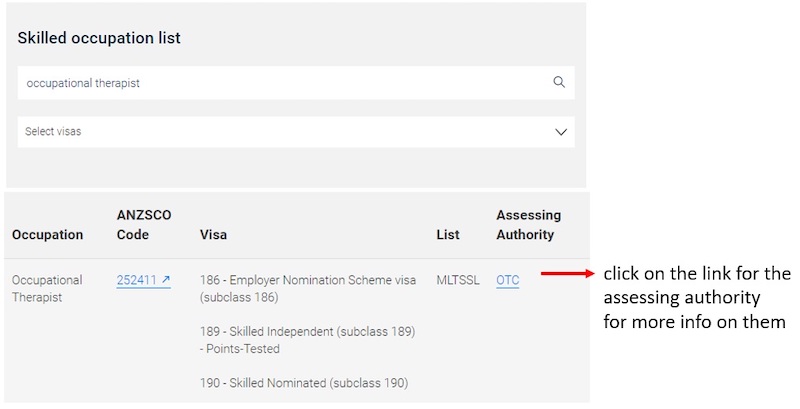
The Australian Department of Home Affairs will only accept a skills assessment issued by the relevant assessing authority. So, make sure to work with the correct one.
Each assessment authority has its processes and timelines. They also have different fees. So, you’ll need to research or ask your agency about the steps you need to take.
d. Avoid Work Visa Scams
Lastly, be wary of people taking advantage of you for wanting to work in Australia. There are several scams out there, and to protect yourself, you need to:
- Know your workplace rights and employer’s obligations32 to you
- Know that sponsors asking to be paid for visa sponsorship is an illegal practice
- Know that you can report any scams that you encounter to the Fair Work Ombudsman and the Australian Competition and Consumer Commission (ACCC)
3. Prepare for the Move to Australia
After getting your visa, you can start preparing to move to Australia.
- Buy a document holder where you can keep your passport, work visa, contract, and other essential items safe. You can also check the Australian Border Force website for the list of prohibited items so that you can get into the country without any hiccups.
- Research the weather in the state or territory where you will be living in. Because Australia is so vast, the weather differs depending on the location. For example, the northern sections of Australia have a more tropical climate. Meanwhile, those in the south have milder summers and rainy winters. Prepare your luggage accordingly.
- It’s essential to have a place to stay when you land in the country, especially after a long flight. For reference, the flight from Manila to Sydney takes more than 8 hours. So, make sure to secure your accommodations before you leave.
- Carry enough cash in AUD or USD for your first few weeks in Australia. While it’s not hard to open a bank account there, it’s best to be prepared for unexpected events. You can also try to find out if any digital options are available, so you can freely send money from the Philippines to Australia.
- Make sure to practice your English speaking, writing, and listening skills. Australian English is closer to British English and may differ slightly from what you are used to. Listen to Australian videos online to better understand their accent and vocabulary.
- You may want to start networking with other Filipinos living in Australia through forums such as the Pinoy Australia Information Forum. Not only will you get crucial tips on what you should bring, but you may also be able to make a friend there before leaving on your journey.
4. Arrive in Australia
Once you arrive in Australia, make sure to do the following things so that you can live comfortably and be legally compliant there:
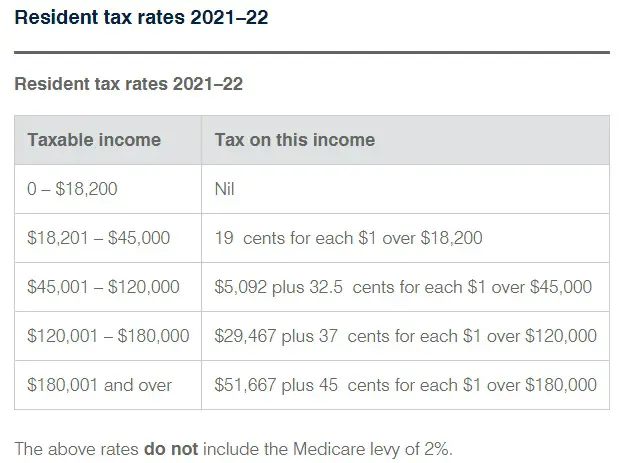
- Get your Tax File Number (TFN) from a nearby Australian Tax Office (ATO) branch or through their online application form. Depending on the visa you received, you can be classified as a permanent migrant or temporary worker. However, they have the same tax obligations that follow the resident income tax rates33. The main difference in tax obligation for a permanent and temporary worker is that a temporary worker is not required to pay the Medicare levy.
- If you arrive in Australia as a temporary worker, you cannot access Medicare privileges yet. So, you should probably get your private insurance to help you save money when you need medical attention.
- Make sure to coordinate with your employer if they’ll open a bank account for your payroll. But if you have to open one alone, there’s no problem since opening a bank account in Australia is easy and inexpensive. The four big banks, National Australia Bank, Commonwealth Bank, ANZ Bank, and Westpac, allow non-residents to open accounts.
- Experience the renowned Australian laid-back culture for yourself. Try to see if there are local sports clubs or social associations that pique your interest. If you join one of them, you can learn more about the Australian culture and integrate yourself into the community much easier.
- Prepare yourself for dangerous animals and natural disasters. Most local government councils in Australia have an emergency warning system in place. Ensure you know how these work to respond accordingly if needed.
- If you have a temporary or provisional work visa, it’s also an excellent time to check what you need to work on to get a permanent visa eventually. For example, if you are working towards getting the 186 Employer Nomination Scheme visa, find out how to raise your chances. That way, you work towards a goal and won’t be blindsided.
The Advantages of Working in Australia
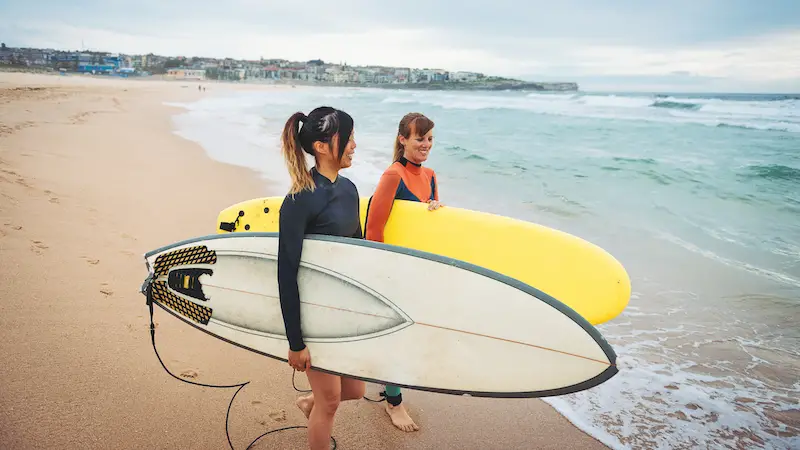
Working and living in Australia benefits Filipinos aspiring for a better life. If you plan on working there, here are some advantages that you can expect:
1. Top-Tier Standard of Living
Based on a 2020 report from the United Nations34, Australia ranks 8th in the world on the Human Development Index (HDI). HDI measures life expectancy, access to knowledge, and a decent standard of living. Australia has also consistently ranked among the top 10 since the 1990s.
2. Better Compensation
The current national minimum wage in Australia is $20.33/hr35 (AUD) or $162.64 for an 8-hour workday. This is equivalent to about PHP 6,286.36, about 11 times more than the minimum wage in Manila. If you find yourself in a job that’s in demand, you will likely be compensated much more.
3. Affordable, Quality Healthcare
Medicare, Australia’s universal health insurance scheme, will be available once you become a permanent resident in Australia. By getting Medicare, you can access free or low-cost healthcare options in Australia’s public healthcare systems. You can also opt for private health insurance once you enter the country as a temporary worker.
4. Abundant Filipino Communities
With Filipinos being the 5th largest migrant population in Australia, it’s no surprise that there are a healthy amount of Filipino communities36 that you can join. Communities exist for specific professions, regional areas, sports, and more. By joining one, you can adjust to life in Australia much more smoothly. Community websites, such as the Pinoy Australia Information Forum, are dedicated to helping fellow Filipinos with their move.
5. Great for Filipinos Active in Sports
Australians live a very active lifestyle and enjoy many different kinds of sports. If you are active in sports yourself, you can join local sports clubs and build a connection with others in your community. They have clubs for basketball, the Filipino favorite, rugby, soccer, cricket, and many others.
6. Laid-Back Lifestyle & Love of Nature
Well-known for a relaxed and casual attitude, Australians work hard and then play hard right after. Working hours in Australia are capped at 38 hours per week37 by law. If you dream of a work-life balance, you might achieve it in Australia. And what better way to use your free time than to explore the country’s natural beauty?
Related: How To Apply for an Australian Tourist Visa
The Disadvantages of Working in Australia
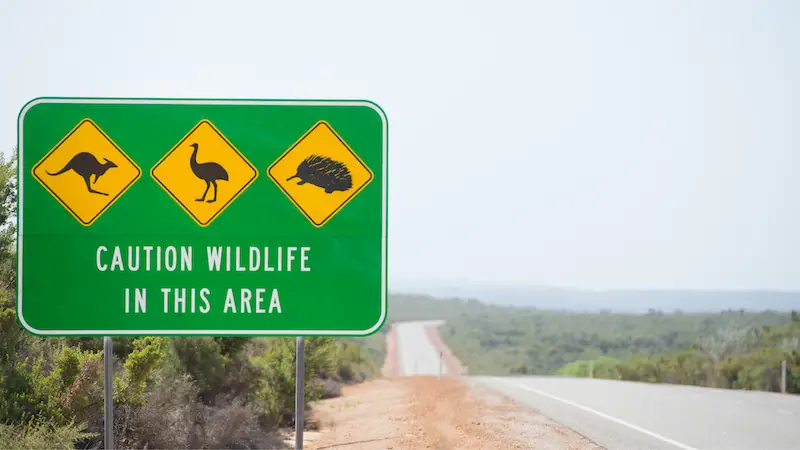
No country is perfect for everyone. Some disadvantages of working in Australia may be a deal-breaker for you. To give you a clear picture, here are a few examples:
1. Expensive Living Expenses
According to Numbeo38, the cost of living in Australia is on average 120% higher than in the Philippines. They also estimate rent to be three times more expensive. That’s why when considering taking a job or not, compute your actual take-home pay to gauge whether the income is worth the move accurately. Don’t forget to include your taxes.
2. Natural Disasters & Dangerous Animals
From bushfires to floods, Australia has been racked by natural disasters yearly. According to a report by Deloitte Access Economics39, natural disasters cost Australia an average of $38 billion per year. So, make sure you are prepared for these scenarios when you go there. Lastly, don’t forget to ask the locals about the dangerous wildlife in the area.
3. Interstate Travel Is Time-Consuming
Australia has a lot of top-tier destinations, such as modern cities and beautiful seascapes; however, they are often far from each other. For reference, Melbourne is almost 900 kilometers away from Sydney. It takes almost half a day to travel by car or train. If you want to get there fast, take a plane.
4. Expensive Cross-Country Travel
If you plan to use your savings to travel a lot, then know that airfare from Australia to popular travel destination countries, such as Japan, can be costly. This is because Australia is located far away in the Southern Hemisphere. However, Bali, Indonesia, and New Zealand are reasonably close.
Life in Australia for Filipinos: A Brief History & Overview
The first recorded Filipinos in Australia were in the 1870s40 when they worked as seamen, traders, and pearl divers around Queensland and Western Australia.
By 1901, a total of 690 Filipinos were now living in Australia. This number would stagnate due to the introduction of the White Australia Policy41 in the same year.
Australia and the Philippines also have military ties42 as countries that fought together during the Second World War.
After easing immigration policies in 1952, Filipino tradesmen and nurses were recruited to contribute to the growth of Australia. The declaration of martial law in the Philippines in 1972 also accelerated the movement of Filipinos to other countries, including Australia.
By the early 2000s, there were more than 100,000 Philippine-born migrants in the country. Fast forward to 2017, about 1 in 10 Filipino OFWs now choose Australia43 as their destination.
As of 2019, Filipinos remain the fifth largest migrant group in Australia, with the population increasing year on year. New South Wales has the most significant number of Filipinos, followed by Victoria, Queensland, Western Australian, and South Australia.
Because most Filipino migrants are invited to the country to help with the labor shortage, almost 75% of Filipino migrants are actively working44. And, about 4 in 10 Filipinos are employed in a skilled trade, managerial, or professional occupation.
Tips and Warnings
1. Australia’s borders have reopened; however, there are rules in place for the prevention of COVID-19
If you are traveling by plane, you must submit a Digital Passenger Declaration (DPD)45 within 72 hours before your flight to Australia.
To enter Australia, you must provide evidence that you are fully vaccinated46 with any of the accepted brands, namely: AstraZeneca Vaxzevria, AstraZeneca Covishield, Pfizer/Biontech Comirnaty, Moderna Spikevax or Takeda, Sinovac Coronavac, Bharat Biotech Covaxin, Sinopharm BBIBP-CorV, Gamaleya Research Institute Sputnik V, or Novavax/Biocelect Nuvaxovid.
If you are not vaccinated for medical reasons47, you also need to prepare ample evidence.
2. Keep yourself updated on the latest job and agency scams
You can do this by following DMW’s social media pages. Some common signs that a job is a scam are:
- There are no details about the job, and they refuse to provide more information.
- There is no information about their company on the Internet. They also have no website or social media pages.
- They are asking you to pay money first before you can get hired.
- They contacted you spontaneously when you didn’t apply to them. This is a common tactic of scammers who steal your identity.
Frequently Asked Questions
1. Do I have to pay a placement fee to an agency to get work in Australia?
Placement fees for work in Australia through a POEA-accredited agency are case-to-case. These agencies can charge a placement fee, but it must not exceed one month’s worth of your salary, as indicated on your contract with your Australian employer.
Some recruitment agencies may not charge a placement fee since they get their fees solely from foreign employers. In cases where you think the recruitment agency is charging you excessively, you can contact DMW for assistance.
2. How much will getting work in Australia through a POEA-accredited agency cost?
Aside from the placement fee, recruitment agencies don’t charge anything else to help you find work in Australia.
You will also pay for Philippine government agencies, language testing, skills assessment authorities, and the Australian government.
Here’s a quick breakdown of these costs:
Documentation Fees: ₱3,935 (includes passport, NBI clearance, birth certificate, PhilHealth contribution, and Pag-IBIG membership)
Australian Visa: depends on the visa type, but $4,115 (AUD) is a safe estimate
Skills Assessment: depends on the assessing authority, but $500 (AUD) is a safe estimate
Language Testing: From ₱11,650
These are estimates, and fees may change without prior notice.
3. Can I apply for a job directly with Australian employers?
According to Section 123 of POEA’s rules and regulations48, there is currently a ban on direct hiring. Except for a few exceptions, Australian employers and agencies are required by POEA (now DMW) to course their recruitment through accredited agencies49.
You can indeed apply directly through SkillSelect or online job boards. However, suppose you do get hired through them. In that case, you and your Australian employer will still need to coordinate with various Philippine and Australian government agencies so that your employment can push through.
4. Are there jobs through POEA-accredited agencies that can lead to a permanent visa?
Yes, some jobs you can get through POEA-accredited agencies are listed under Australia’s skilled occupation list. They are looking to hire migrant workers to address shortages in those occupations.
You can check the visas available for a particular job by using the search function on the page for the skilled occupation list.
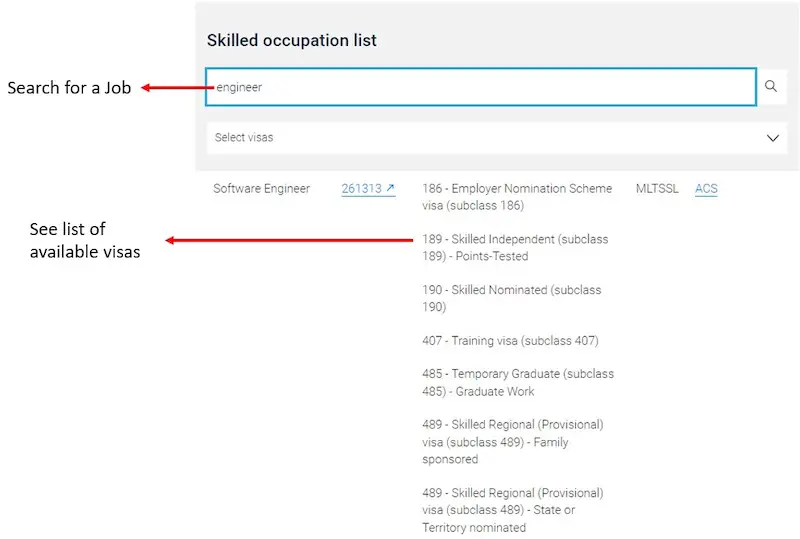
You are looking for jobs where you can apply for a permanent visa, such as 189 or 190. But some temporary visas (482) and provisional ones (491 or 494) can also lead to permanent visas.
5. Can I apply for work in Australia even without a visa?
It’s normal to apply for work first before getting a visa. One of the requirements for getting most of the available work visas in Australia is an employment contract. And you can’t enter the country without a valid visa.
Note that it’s best to apply with a plan in mind, especially if you want your work in Australia to lead to permanent residence.
6. Can I work in Australia without taking a language test?
No. Working visas in Australia have a minimum English language proficiency requirement that you have to meet. Depending on the visa, the requirements are also different, so you need to check the Australian Department of Home Affairs website.
For example, a permanent visa Skilled Nominated (subclass 190) requires at least a 6 score50 in all 4 of the IELTS components. Meanwhile, the medium-term stream of temporary visa TSS (subclass 482) requires at least a 5 overall band score51 and a minimum 5 score in each component in IELTS.
7. Are there jobs in Australia available for Filipinos without work experience?
In Australia, finding jobs for foreign workers without work experience is challenging. Even typical laborer jobs on farms require a certain degree of competency. Australians, after all, take pride in their agricultural industry.
For example, livestock farmers must have a bachelor’s degree or higher in the related field. Otherwise, at least 5 years of experience is needed as a substitute requirement.
The other route for people without experience is to study and work in Australia. However, you need to choose a field on the skilled occupation list. After studying in Australia, you can apply for the Temporary Graduate Visa (Subclass 485)52. This lets you work in Australia and gives you time to apply for a permanent visa related to your work.
8. How is Australian English different from the English we use in the Philippines?
Australian English is closer to British English in both vocabulary and spelling. Meanwhile, Philippine English is closer to American English. However, as long as you have sufficient English skills, you’ll be able to understand one another without any significant problems.
They use a lot of slang you’ll likely learn as you work there. It’s probably more important to get used to their accent rather than worrying about the differences in vocabulary.
You can try listening to any available Australian media online as practice. That way, you can comfortably converse with the people you meet there once you arrive.
9. Can a Filipino get a working holiday visa in Australia?
All the short-stay work visas53 are unavailable for Filipino citizens. These include the Work and Holiday visa (subclass 462) and Working Holiday visa (subclass 417), which are only available to select countries.
However, if you are a Filipino citizen and passport holder of the allowed countries, you may be able to apply for these visas. The list of countries is different for visas 462 and 417, so you need to check it on their website.
10. Is it easy for Filipinos to find a job in Australia?
Finding a job in Australia as a foreign worker takes a lot of time and hard work. It’s very competitive, and you must stand out from the other applicants worldwide.
To give you an idea of the odds, data from the SkillSelect program is available online. One hundred nine thousand four hundred fifty-one applications were submitted for the Skilled Nominated visa (subclass 190) as of January 2022. Only 1100 were invited to Australia, or just 1% of the total applications.
That’s why working with a POEA-accredited agency that has experience sending Filipino workers to Australia is so beneficial. They already know the processes, so they can guide you step by step.
References
- Philippine Overseas Employment Administration (POEA). (2016). Revised POEA Rules and Regulations Governing the Recruitment and Employment of Land-based Overseas Filipino Workers of 2016 [PDF]. Retrieved from https://www.poea.gov.ph/laws&rules/files/Revised%20POEA%20Rules%20And%20Regulations.pdf
- Embassy of The Philippines in Australia. Guide for Australian Employers on Hiring Filipino Workers and Professionals [PDF]. Retrieved from https://dms.philembassy.org.au/index.php/website/latest/polo-1/69-guide-for-australian-employers-on-hiring-filipino-workers-and-professionals/file
- Competent English. (2022). Retrieved 24 March 2022, from https://immi.homeaffairs.gov.au/help-support/meeting-our-requirements/english-language/competent-english
- English proficiency (subclass 482). (2020). Retrieved 24 March 2022, from https://immi.homeaffairs.gov.au/visas/getting-a-visa/visa-listing/temporary-skill-shortage-482/sufficient-english
- Subclass 485 Temporary Graduate visa. (2021). Retrieved 24 March 2022, from https://immi.homeaffairs.gov.au/visas/getting-a-visa/visa-listing/temporary-graduate-485
- Short stay work visas. (2019). Retrieved 24 March 2022, from https://immi.homeaffairs.gov.au/visas/working-in-australia/short-stay-work-visas
- Masinag, R. (2021). 310,000 Filipino migrants are calling Australia their second home, new data reveals. Retrieved 23 March 2022, from https://www.sbs.com.au/language/english/310-000-filipino-migrants-are-calling-australia-their-second-home-new-data-reveals
- Country profile – Philippines. (2021). Retrieved 23 March 2022, from https://www.homeaffairs.gov.au/research-and-statistics/statistics/country-profiles/profiles/philippines
- Australia ready to welcome back skilled migrant workers. (2022). Retrieved 23 March 2022, from https://www.businesslive.co.za/bd/life/2022-02-22-native-australia-ready-to-welcome-back-skilled-migrant-workers/
- Australian and New Zealand Standard Classification of Occupations, First Edition, 2006 – Unit Group 3223 Structural Steel and Welding Trades Workers. (2006). Retrieved 23 March 2022, from https://www.abs.gov.au/ausstats/[email protected]/0/51CA65855B96BB86CA2571E2008354D4?opendocument
- Australian and New Zealand Standard Classification of Occupations, First Edition, Revision 1 – Minor Group 321 Automotive Electricians and Mechanics. (2009). Retrieved 23 March 2022, from https://www.abs.gov.au/ausstats/[email protected]/Product+Lookup/3D9E7EAF48EF4266CA2575DF002DA6FA?opendocument
- Australian and New Zealand Standard Classification of Occupations, First Edition, Revision 1 – Unit Group 3232 Metal Fitters and Machinists. (2009). Retrieved 23 March 2022, from https://www.abs.gov.au/ausstats/[email protected]/latestproducts/E756DD230C3B94C1CA2575DF002DA786?opendocument
- Australian and New Zealand Standard Classification of Occupations, First Edition, 2006 – Unit Group 3243 Vehicle Painters. (2006). Retrieved 23 March 2022, from https://www.abs.gov.au/ausstats/[email protected]/0/A200F3036C98756BCA2571E2008354DD?opendocument
- Australian and New Zealand Standard Classification of Occupations, First Edition, 2006 – Unit Group 3241 Panelbeaters. (2006). Retrieved 23 March 2022, from https://www.abs.gov.au/ausstats/[email protected]/0/713BF345B7A34F51CA2571E2008354DB?opendocument
- Australian and New Zealand Standard Classification of Occupations, First Edition, Revision 1 – Unit Group 8312 Meat Boners and Slicers, and Slaughterers. (2009). Retrieved 23 March 2022, from https://www.abs.gov.au/ausstats/[email protected]/latestproducts/5DF7B56C6D7DCA82CA2575DF002DA742?opendocument
- Australian and New Zealand Standard Classification of Occupations, First Edition, Revision 1 – Unit Group 1213 Livestock Farmers. (2009). Retrieved 23 March 2022, from https://www.abs.gov.au/ausstats/[email protected]/Latestproducts/A5F3A3E9DE8885E7CA2575DF002DA790?opendocument
- Australian and New Zealand Standard Classification of Occupations, First Edition, Revision 1 – Unit Group 3513 Chefs. (2009). Retrieved 23 March 2022, from https://www.abs.gov.au/ausstats/[email protected]/Product+Lookup/1220.0~First+Edition,+Revision+1~Chapter~UNIT+GROUP+3513+Chefs
- Australian and New Zealand Standard Classification of Occupations, First Edition, Revision 1 – Unit Group 3514 Cooks. (2009). Retrieved 23 March 2022, from https://www.abs.gov.au/ausstats/[email protected]/Previousproducts/171A4AC9F7BF1501CA2575DF002DA793?opendocument
- Australian and New Zealand Standard Classification of Occupations, First Edition, Revision 1 – Unit Group 2524 Occupational Therapists. (2009). Retrieved 23 March 2022, from https://www.abs.gov.au/ausstats/[email protected]/Product+Lookup/308114CEA4967D30CA2575DF002DA71D?opendocument
- Australian and New Zealand Standard Classification of Occupations, First Edition, 2006 – Unit Group 2613 Software and Applications Programmers. (2006). Retrieved 23 March 2022, from https://www.abs.gov.au/ausstats/[email protected]/Product+Lookup/1220.0~2006~Chapter~UNIT+GROUP+2613+Software+and+Applications+Programmers
- Australian and New Zealand Standard Classification of Occupations, First Edition, Revision 1 – Unit Group 2335 Industrial, Mechanical and Production Engineers. (2009). Retrieved 23 March 2022, from https://www.abs.gov.au/Ausstats/[email protected]/Latestproducts/9C5DFE35140635F7CA2575DF002DA72C?opendocument
- Skillselect. (2021). Retrieved 23 March 2022, from https://immi.homeaffairs.gov.au/visas/working-in-australia/skillselect
- Skilled occupation list. (2021). Retrieved 23 March 2022, from https://immi.homeaffairs.gov.au/visas/working-in-australia/skill-occupation-list
- Philippine Overseas Employment Administration (POEA). (2018). POEA Memorandum Circular No. 08 Series of 2018. Mandaluyong City.
- Skilled Independent visa (subclass 189) Points-tested stream. (2022). Retrieved 24 March 2022, from https://immi.homeaffairs.gov.au/visas/getting-a-visa/visa-listing/skilled-independent-189/points-tested
- Subclass 190 Skilled Nominated Visa. (2022). Retrieved 24 March 2022, from https://immi.homeaffairs.gov.au/visas/getting-a-visa/visa-listing/skilled-nominated-190
- Temporary Skill Shortage Visa (Subclass 482) Medium-term Stream. (2022). Retrieved 24 March 2022, from https://immi.homeaffairs.gov.au/visas/getting-a-visa/visa-listing/temporary-skill-shortage-482/medium-term-stream
- Employer Nomination Scheme (Subclass 186) Temporary Residence Transition Stream. (2022). Retrieved 24 March 2022, from https://immi.homeaffairs.gov.au/visas/getting-a-visa/visa-listing/employer-nomination-scheme-186/temporary-residence-transition-stream
- Regional Sponsored Migration Scheme Visa (Subclass 187) Temporary Residence Transition Stream. (2022). Retrieved 24 March 2022, from https://immi.homeaffairs.gov.au/visas/getting-a-visa/visa-listing/regional-sponsor-migration-scheme-187/temporary-residence-transistion-stream
- Subclass 491 – Skilled Work Regional (Provisional) Visa – Main applicant. (2022). Retrieved 24 March 2022, from https://immi.homeaffairs.gov.au/visas/getting-a-visa/visa-listing/skilled-work-regional-provisional-491/application
- Skilled Employer-Sponsored Regional (Provisional) Visa (Subclass 494) Employer-Sponsored Stream. (2022). Retrieved 24 March 2022, from https://immi.homeaffairs.gov.au/visas/getting-a-visa/visa-listing/skilled-employer-sponsored-regional-494/employer-sponsored-stream
- Visa holders and migrant workers – workplace rights and entitlements. (n.d.-c). Retrieved from https://www.fairwork.gov.au/tools-and-resources/fact-sheets/rights-and-obligations/visa-holders-and-migrant-workers-workplace-rights-and-entitlements
- Individual income tax rates. (2021). Retrieved from https://www.ato.gov.au/rates/individual-income-tax-rates/
- Latest Human Development Index Ranking. (2020). Retrieved 24 March 2022, from https://hdr.undp.org/en/content/latest-human-development-index-ranking
- Minimum wages. Retrieved 24 March 2022, from https://www.fairwork.gov.au/tools-and-resources/fact-sheets/minimum-workplace-entitlements/minimum-wages
- Embassy of the Philippines in Canberra, Australia. (2021). Filipino Community Organizations in Australia (As of 2021) [PDF]. Retrieved from https://dms.philembassy.org.au/index.php/website/the-philippines/742-directory-of-filipino-communities-in-australia-2/file
- Hours of work. Retrieved 24 March 2022, from https://www.fairwork.gov.au/employment-conditions/hours-of-work-breaks-and-rosters/hours-of-work
- Cost of Living in Australia. (2022). Retrieved 24 March 2022, from https://www.numbeo.com/cost-of-living/country_result.jsp?country=Australia
- Natural Disasters estimated to cost Australia $73 billion per year by 2060. (2021). Retrieved 24 March 2022, from https://www.iag.com.au/newsroom/community/natural-disasters-estimated-cost-australia-73-billion-year-2060
- Ancestry – Filipino. Retrieved 24 March 2022, from https://multiculturalnsw.id.com.au/multiculturalnsw/ancestry-introduction?COIID=248
- Heanue, S. (2017). White Australia Policy: Documents reveal personal stories of life under Immigration Restriction Act. Retrieved 24 March 2022, from https://www.abc.net.au/news/2017-09-04/white-australia-policy-project-transcribes-history/8868680
- Australian Philippine History and Memorials. Retrieved 24 March 2022, from https://philippines.embassy.gov.au/mnla/defence-history.html
- Bevan, K. (2018). Why so many Filipinos choose Australia as their second home. Retrieved 24 March 2022, from https://www.worldremit.com/en/stories/story/2018/01/26/filipinos-australia
- Filipinos in Australia. Retrieved 24 March 2022, from https://culturalatlas.sbs.com.au/filipino-culture/filipino-culture-filipinos-in-australia
- Digital Passenger Declaration. (2022). Retrieved 24 March 2022, from https://www.homeaffairs.gov.au/covid19/digital-passenger-declaration
- Vaccination and testing. (2022). Retrieved 24 March 2022, from https://www.homeaffairs.gov.au/covid19/vaccination-testing#content-index-2
- Unvaccinated international travellers. (2022). Retrieved 24 March 2022, from https://www.homeaffairs.gov.au/covid19/unvaccinated-travellers/temp-visa-holders/entering-and-transiting-australia
- Philippine Overseas Employment Administration (POEA). (2016). Revised POEA Rules and Regulations Governing the Recruitment and Employment of Land-based Overseas Filipino Workers of 2016 [PDF]. Retrieved from https://www.poea.gov.ph/laws&rules/files/Revised%20POEA%20Rules%20And%20Regulations.pdf
- Embassy of The Philippines in Australia. Guide for Australian Employers on Hiring Filipino Workers and Professionals [PDF]. Retrieved from https://dms.philembassy.org.au/index.php/website/latest/polo-1/69-guide-for-australian-employers-on-hiring-filipino-workers-and-professionals/file
- Competent English. (2022). Retrieved 24 March 2022, from https://immi.homeaffairs.gov.au/help-support/meeting-our-requirements/english-language/competent-english
- English proficiency (subclass 482). (2020). Retrieved 24 March 2022, from https://immi.homeaffairs.gov.au/visas/getting-a-visa/visa-listing/temporary-skill-shortage-482/sufficient-english
- Subclass 485 Temporary Graduate visa. (2021). Retrieved 24 March 2022, from https://immi.homeaffairs.gov.au/visas/getting-a-visa/visa-listing/temporary-graduate-485
- Short stay work visas. (2019). Retrieved 24 March 2022, from https://immi.homeaffairs.gov.au/visas/working-in-australia/short-stay-work-visas
Rod Michael Perez
Rod Michael Perez is a freelance writer with over 7 years of experience in writing long-form articles, ad copy, and SEO content for local and foreign clients. He is also an aspiring startup founder and believes that the Philippines could be the next hub for startup culture. He takes care of his dog, a poodle-Shih Tzu hybrid, in his spare time.
Copyright Notice
All materials contained on this site are protected by the Republic of the Philippines copyright law and may not be reproduced, distributed, transmitted, displayed, published, or broadcast without the prior written permission of filipiknow.net or in the case of third party materials, the owner of that content. You may not alter or remove any trademark, copyright, or other notice from copies of the content. Be warned that we have already reported and helped terminate several websites and YouTube channels for blatantly stealing our content. If you wish to use filipiknow.net content for commercial purposes, such as for content syndication, etc., please contact us at legal(at)filipiknow(dot)net